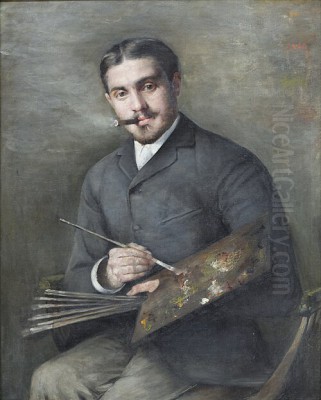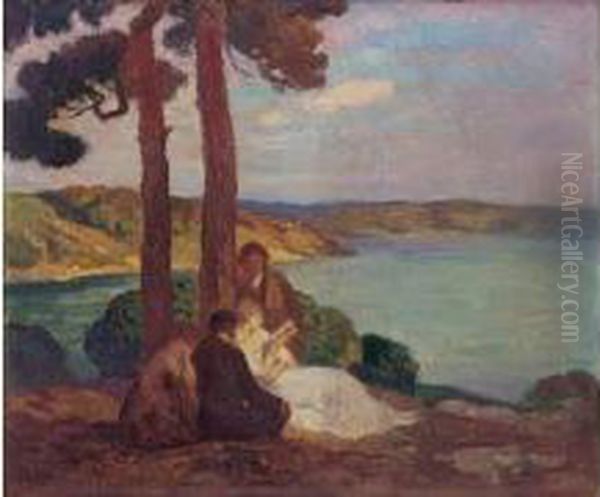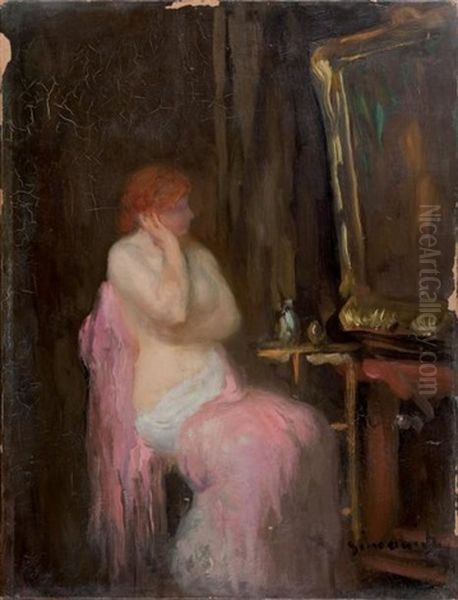
Michel Simonidy (1870-1933) stands as a significant, albeit sometimes overlooked, figure in the vibrant tapestry of European art at the turn of the 20th century. A Romanian-born artist whose career predominantly flourished in the artistic crucible of Paris, Simonidy masterfully navigated the currents of Art Nouveau and Symbolism, leaving behind a body of work characterized by its elegance, evocative power, and decorative sensibility. His contributions spanned painting, illustration, and the broader decorative arts, establishing him as a versatile and sensitive interpreter of the era's aesthetic and intellectual preoccupations.
Early Life and Artistic Awakening
Born in Bucharest, Romania, in 1870, Mihail Simonidi, later known as Michel Simonidy, emerged from a cultural environment that was increasingly looking towards Western Europe, particularly Paris, for artistic inspiration. While details of his earliest artistic inclinations in Romania are not extensively documented, it is clear that the allure of Paris, then the undisputed capital of the art world, proved irresistible. Like many aspiring artists of his generation from across Europe and beyond, Simonidy made the pivotal decision to relocate to Paris to immerse himself in its dynamic artistic milieu and pursue formal training.
His artistic talents were further honed at the prestigious École des Beaux-Arts in Paris. This institution, while often associated with a conservative academic tradition, provided a rigorous foundation in drawing, composition, and art history. During his formative years in Paris, Simonidy studied under several notable academic painters. Among his mentors were Léon Bonnat (1833-1922), a celebrated portraitist known for his realistic and powerful depictions; Fernand Humbert (1842-1934), another respected academic painter who also taught figures like Georges Braque and Francis Picabia; and Gabriel Ferrier (1847-1914), a Prix de Rome winner recognized for his historical and portrait paintings. The tutelage under these masters would have equipped Simonidy with a strong technical skill set, even as he gravitated towards more contemporary stylistic expressions. His father was also reportedly a painter, suggesting an early familial exposure to the arts that may have nurtured his burgeoning talent.
The Parisian Art Scene: A Crucible of Innovation

The Paris that Simonidy inhabited was a city teeming with artistic innovation and intellectual ferment. The late 19th and early 20th centuries witnessed a profound shift away from the strictures of academic art, giving rise to a plethora of new movements. Two of the most influential currents during Simonidy's active years were Art Nouveau and Symbolism, both of which profoundly shaped his artistic vision.
Art Nouveau, flourishing roughly between 1890 and 1910, was an international style of art, architecture, and applied arts—especially the decorative arts—that sought to create a new aesthetic language, free from the imitation of historical styles. It was characterized by its use of long, sinuous, organic lines, often taking the form of flower stalks and buds, vine tendrils, insect wings, and other delicate natural objects. Artists like Hector Guimard with his iconic Paris Métro entrances, Alphonse Mucha with his decorative posters, and René Lalique with his exquisite jewelry were central to this movement in Paris. The influence of Art Nouveau is palpable in Simonidy's work, particularly in its decorative qualities, fluid lines, and often idealized portrayal of female figures.
Concurrently, Symbolism emerged as a literary and artistic movement that reacted against Naturalism and Realism. Symbolist artists and writers sought to express individual emotional experience through the subtle and suggestive use of symbols, prioritizing subjectivity, spirituality, and the imagination. They delved into themes of dreams, mythology, decadence, and the inner world of the psyche. Key figures in Symbolist painting included Gustave Moreau, whose work was rich in mythological and biblical allegory; Odilon Redon, known for his dreamlike and often unsettling imagery; and Pierre Puvis de Chavannes, whose serene, allegorical murals had a profound impact on many younger artists, including Simonidy. The introspective and often melancholic mood of Symbolism, its emphasis on atmosphere, and its exploration of deeper meanings resonated strongly in Simonidy's thematic choices and compositions.
Simonidy's Artistic Style: A Synthesis of Elegance and Meaning
Michel Simonidy's artistic output is a compelling synthesis of Art Nouveau's decorative elegance and Symbolism's evocative depth. He was a versatile artist, proficient in various media including oil painting, gouache, watercolor, pastel, and illustration. His subject matter was diverse, encompassing portraits, landscapes, still lifes, nudes, and, most notably, compositions imbued with symbolic and allegorical meaning.

A recurring motif in his work is the elegant, often ethereal, female figure. These women are not merely subjects of portraiture but often serve as personifications of moods, seasons, or abstract concepts, aligning with the Symbolist tendency to explore the inner world through external forms. His figures are typically rendered with a graceful linearity, their forms often enveloped in flowing drapery or set against atmospheric, dreamlike backgrounds. This approach reflects the Art Nouveau emphasis on sinuous lines and decorative harmony.
His landscapes, too, often transcend mere topographical representation. They are frequently imbued with a particular mood or atmosphere, suggesting a deeper emotional or spiritual resonance. Works like Parfums d'hiver (Winter Perfumes) evoke not just a season but the sensory and emotional qualities associated with it. The influence of Puvis de Chavannes can be discerned in the often muted palettes and the sense of timeless serenity that pervades some of his compositions.
Simonidy also engaged with themes characteristic of Decadentism, a late 19th-century artistic and literary movement, centered in Western Europe, that followed an aesthetic ideology of excess and artificiality. This is evident in some of his works that explore more enigmatic or melancholic subjects, reflecting the era's fascination with introspection, the ephemeral, and the subtly unsettling.
His skill as an illustrator further highlights his connection to the literary and decorative trends of the time. He created illustrations and book covers, demonstrating a keen understanding of how visual art could complement and enhance literary texts, a common practice among Art Nouveau and Symbolist artists like Aubrey Beardsley in England or Georges de Feure in France. Simonidy reportedly viewed painting as "silent poetry," emphasizing a conceptual link between the methods of visual and literary creation, suggesting that painters depict actions as they happen, while language describes them retrospectively.
Key Works and Their Significance
Several works stand out in Michel Simonidy's oeuvre, illustrating the key facets of his artistic style and thematic concerns.
Parfums d'hiver (Winter Perfumes/Fragrances), created around 1899, is perhaps one of his most celebrated pieces. This painting, which gained recognition at the 1900 Paris Exposition Universelle, exemplifies the Art Nouveau style and Symbolist sensibility. While the specific visual details of the painting require direct observation for a full appreciation, its title alone suggests an evocative, sensory experience, likely featuring a female figure embodying the essence of winter, perhaps surrounded by symbolic elements that convey coldness, introspection, or the delicate beauty of the season. Its success at the Exposition Universelle underscores its alignment with the prevailing tastes and artistic values of the "1900 style."
Deux Baigneuses (Two Bathers), dated 1910, showcases his skill in depicting the human form, particularly the female nude, a common subject in both academic and modernist art. The treatment of bathers allows for an exploration of the figure in a natural, often idyllic setting, a theme explored by artists from Jean-Auguste-Dominique Ingres to Paul Cézanne and Pierre-Auguste Renoir. Simonidy's interpretation would likely combine graceful figuration with an atmospheric quality, possibly hinting at a deeper symbolic meaning beyond the simple depiction of nudes.
Armonia della sera (Evening Harmony), an oil painting from 1908, further points to his Symbolist leanings. The title suggests a focus on mood and atmosphere, a common preoccupation for Symbolist artists like James McNeill Whistler, whose "Nocturnes" captured the poetic qualities of twilight and night. Simonidy's work likely aimed to evoke the tranquility, mystery, or melancholy of evening through a harmonious composition and subtle color palette. This piece is noted for its connection to Decadent and Symbolist themes.
La lecture (The Reading), exhibited in 1912 at the Salon de la Société Nationale des Beaux-Arts, is another significant work. Depictions of women reading were popular, often symbolizing introspection, education, or quiet domesticity. Artists like Jean-Honoré Fragonard, Berthe Morisot, and Mary Cassatt famously explored this theme. Simonidy's version would likely be infused with his characteristic elegance and perhaps a subtle psychological depth.
Other works, known through auction records and collection listings, such as Femme devant un miroir (Woman before a Mirror, c. 1908), Bord de mer (Seaside, c. 1908), and La belle sorcière (The Beautiful Sorceress, c. 1908), further illustrate his thematic range, from intimate interior scenes and evocative landscapes to more overtly Symbolist or fantastical subjects. His Nude Sketch indicates his foundational practice in figure drawing.
Exhibitions, Recognition, and Connections
Michel Simonidy was an active participant in the Parisian art world, exhibiting his work regularly and gaining notable recognition. His participation in the Salons was crucial for visibility and critical reception. He exhibited at the Salon de la Société Nationale des Beaux-Arts between 1908 and 1912, a prestigious venue that showcased contemporary art. He also reportedly participated in an exhibition titled "La Mort de Minerve" (The Death of Minerva) during this period.
A significant early achievement was his recognition at the 1889 Exposition Universelle (World's Fair) in Paris, where he received an honorable mention. However, his triumph at the 1900 Paris Exposition Universelle, where he was awarded a silver medal (some sources also mention a nomination), marked a high point in his career. These grand international expositions were major cultural events, and receiving an award there brought considerable prestige. For his artistic achievements, Simonidy was also honored with the distinction of Chevalier of the Legion of Honour, a significant French order of merit.
Simonidy's artistic development was shaped by his teachers—Léon Bonnat, Fernand Humbert, and Gabriel Ferrier—who provided him with a solid academic grounding. However, his stylistic affinities clearly lay with the Symbolist and Art Nouveau movements. He would have been aware of, and likely influenced by, leading figures of these movements. The ethereal figures and dreamlike atmospheres in his work echo the spirit of Symbolists like Gustave Moreau, Odilon Redon, and Fernand Khnopff. The decorative elegance and sinuous lines connect him to Art Nouveau practitioners such as Alphonse Mucha and, in a broader European context, Gustav Klimt of the Vienna Secession, whose ornate and symbolic works also often featured idealized female figures.
The influence of Pierre Puvis de Chavannes is particularly noted, and it's easy to see how Puvis's serene, allegorical compositions, with their muted colors and emphasis on harmonious design, would have appealed to Simonidy's temperament. He was part of the broader "École de Paris," a term often used to describe the diverse community of artists, many of them foreign-born, who flocked to Paris in the late 19th and early 20th centuries, contributing to its status as the global center of artistic innovation. This milieu included artists working in a wide range of styles, from Post-Impressionists to Fauves and Cubists, though Simonidy's work remained more closely aligned with the fin-de-siècle aesthetics of Symbolism and Art Nouveau. Other Romanian artists active in Paris around this time, or slightly later, included Constantin Brâncuși, who revolutionized sculpture, though their artistic paths diverged significantly.
While direct collaborations with other specific painters are not extensively documented, the Parisian art scene was one of intense interaction, shared exhibitions, and mutual influence. Artists frequented the same cafés, galleries, and salons, fostering an environment of constant artistic dialogue. Simonidy's unique creative process, which included a habit of revising his work extensively and even reading his own writings aloud to ensure coherence, suggests a deeply thoughtful and meticulous approach to his art, perhaps reflecting the era's emphasis on the artist as a sensitive and intellectual creator.
Later Career, Legacy, and Collections
Michel Simonidy continued to work and exhibit in Paris throughout the early decades of the 20th century. His style, rooted in Art Nouveau and Symbolism, likely evolved, but he remained committed to an art that emphasized beauty, emotion, and symbolic meaning, even as more radical avant-garde movements like Cubism and Surrealism began to dominate the Parisian art scene.
He passed away in Paris in 1933, at the age of 63. His death marked the end of a career dedicated to capturing the subtle nuances of emotion and the decorative possibilities of form. While perhaps not as widely known today as some of his more revolutionary contemporaries like Pablo Picasso or Henri Matisse, Simonidy's work holds an important place within the context of late Symbolism and Art Nouveau.
His paintings and illustrations are preserved in several public and private collections. Notably, the Musée d'Orsay in Paris, a museum renowned for its collection of Impressionist and Post-Impressionist art but also encompassing works from the late 19th and early 20th centuries, holds some of his pieces, including La lecture. This inclusion signifies his recognition within the canon of French art of the period.
In his native Romania, his work is also appreciated. The Muzeul Ţării Crișurilor in Oradea is a significant repository of his art, holding important pieces like Parfums d'hiver and Armonia della sera. The presence of his works in Romanian collections underscores his enduring connection to his country of origin and his place within Romanian art history, despite his career being largely based in France. His works also appear in art auctions, attesting to a continued interest among collectors.
Conclusion: An Enduring Vision of Beauty and Symbol
Michel Simonidy was an artist of refined sensibility and considerable technical skill, who made a distinctive contribution to the Art Nouveau and Symbolist movements. His work, characterized by its elegant portrayal of the female form, its evocative atmospheres, and its harmonious decorative qualities, captures the spirit of the fin-de-siècle—an era of artistic transition, intellectual exploration, and a profound appreciation for beauty and subjective experience.
From his early training under academic masters to his embrace of contemporary artistic currents, Simonidy forged a personal style that resonated with the aesthetic ideals of his time. His paintings and illustrations offer a window into a world of dreamlike beauty, subtle emotion, and symbolic depth. While the grand narratives of art history often focus on the most radical innovators, artists like Michel Simonidy play a crucial role in fleshing out the richness and diversity of a period. His dedication to "silent poetry" in his art ensures that his vision continues to speak to those who appreciate the enduring power of elegance, symbolism, and meticulously crafted beauty. His legacy, preserved in museums and private collections, remains a testament to a dedicated artistic journey that bridged Romanian roots with the vibrant heart of Parisian modernism.